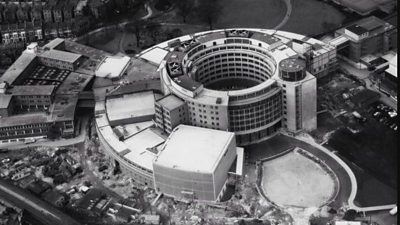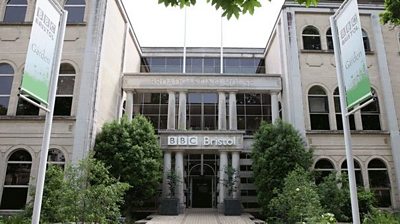Origins
When broadcasting to the West of England was established with 大象传媒 Wales (5WA) in Cardiff in 1923, the Western region was combined with Wales, but after campaigning by local councils and MPs, the West was granted its own service - the West of England Home Service - in 1937.
Bristol's Lord Mayor officially opened 大象传媒 Bristol's four studios at 23 Whiteladies Road on 18 September 1934. Each studio was designed for a different acoustic purpose: orchestral, drama, sound effects and "talking".
World War II
Bristol's role was transformed during World War II when the Corporation moved its major departments out of London - the 大象传媒 Symphony Orchestra, school and children's programmes, religion and variety teams - some 700 people - all headed West.
By 1940, six studios had been established at Broadcasting House on Whiteladies Road as the 大象传媒 eventually acquired the surrounding houses. The 大象传媒 also used other locations across the city for programme-making: Redland Park Hall, All Saints Hall, College Road, the Chapter House, Clifton Parish Hall and Co-operative Hall.
With the fall of France, Bristol came within bombing range of the Luftwaffe and so the 大象传媒 headed further west into Wales and underground to the Clifton Rocks Railway in Bristol. A transmitter, studio and control room - and an "ozoneator" to combat the smell of the river - were all concealed in the railway tunnel.
London was able to quickly switch to broadcasting in Bristol - sometimes mid-news bulletin - when the capital was under attack. It's thought that the German Air Force used 大象传媒 transmitters to guide bombers to their targets, so engineers switched transmitters to put them off course.
Television moves in, and the Natural History Unit is founded
After the war, the 大象传媒 in Bristol developed some pioneering radio programmes, like Any Questions, which was first broadcast on the West of England Home Service in 1948.
In 1945, Desmond Hawkins joined the 大象传媒 and began producing a long-running series, The Naturalist. He went on to found the Natural History Unit (NHU) and discovered broadcasting legend Johnny Morris. The NHU's highly-acclaimed Life on Earth series was aired on 大象传媒 Two in 1979. It took producer David Attenborough and his team three years to film and edit what was the unit's most ambitious project since its inception.
Regional news programme Points West began as a five-minute television news show in September 1957. The show was extended to 10 minutes and then to 20 in 1964. Other regional programmes were produced in Bristol too: like the popular Days Out with Glyn Richards and RPM with Andy Batten-Foster.
Fast forward to 1970 and the establishment of 大象传媒 Radio Bristol. The station's original line-up included broadcasting greats Kate Adie and Michael Buerk. In 1977 the General Programmes Unit (GPU) was set up in Bristol, which made primetime shows such as Antiques Roadshow and editions of Whicker's World.
Network Production Centre
In 1984, as the 大象传媒 celebrated 50 years in Bristol, a new building was planned adjacent to the site where those four studios first opened in 1934. The Network Production Centre, built on the corner of Whiteladies Road and Belgrave Road, is now the gateway to all the 大象传媒 units based in Bristol.
Following the closure of 大象传媒 Pebble Mill, Bristol became the home of many long-running programmes including Countryfile and Gardener's World and Natural History Unit series such as Blue Planet II and the popular live Watches series (Spring/Autumn/Winterwatch). 大象传媒 Studios and the Natural History Unit moved to a new site at Bridgewater House in Bristol in 2022.
Buildings
-

Alexandra Palace
The birthplace of television -

Broadcasting House
The first purpose-built broadcast centre in the UK -

Broadcasting House, Belfast
大象传媒 Northern Ireland's headquarters since 1941 -

Broadcasting House, Bristol
Former home of the Natural History Unit -

Broadcasting House, Cardiff
The 大象传媒's first bespoke headquarters in Wales -

Bush House
Home of the World Service 1940-2012 -

Camden Palace Theatre
Light entertainment and music from North London -

Caversham Park
Listening to the world, 1943 to 2018 -

Ealing Studios
The 大象传媒 Television Film Studios -

Elstree Studios
Home of EastEnders -

Lime Grove
A temporary measure for 42 years -

Kingswood Warren
Former home of 大象传媒 Research & Development -

The Langham
Sustaining the 大象传媒 during World War 2 and after -

Maida Vale
The best acoustic in London -

35 Marylebone High Street
The first headquarters of the Radio Times and 大象传媒 Radio London. -

MediaCityUK
The 大象传媒's Northern base in Salford -

Pacific Quay
Headquarters of 大象传媒 Scotland -

Paris Studios
Former London cinema which hosted The Beatles and Dad's Army -

Pebble Mill
A hub for drama, entertainment and factual programmes in Birmingham between 1971 and 2004 -

Queen's House, WC2
Centre of English language learning -

Riverside Studios
A film studio regenerated into a TV studio used by the 大象传媒 from 1954 to 1975 -

Savoy Hill
The first home of the 大象传媒 -

Television Centre
The Television Factory -

Television Theatre
A mecca for the stars of the 1960s -

Wood Norton
The emergency broadcasting centre
